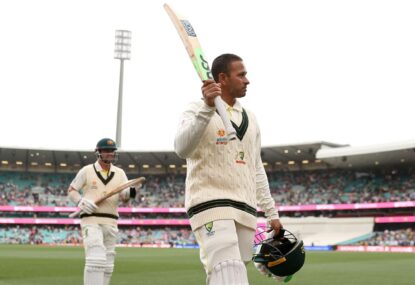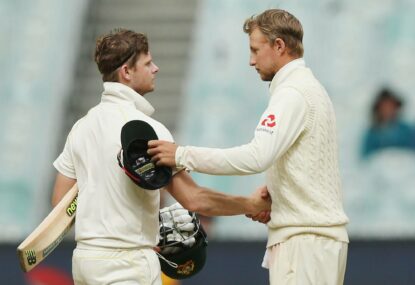Now that the current ICC World Test Championship cycle has ended (except the WTC final of course), we can now look at creating a XI for this cycle’s ICC WTC.
This is based on statistics, understanding of the conditions they played in (home vs away), comments from experts, team balance and of course, my own personal opinion.
There are other strong contenders are there(particularly those in honourable XI) and this is in no way undermining their performance or challenging anyone else’s perfectly valid opinions.
1. Usman Khawaja (Australia)
Usman Khawaja’s performance in the current Test Championship cycle has been remarkable. He has surpassed David Warner to become the top Australian Test opener, and by a significant margin, he has also been the best batsman in terms of average (in over 15 innings).
His progress has been extraordinary since he started playing, and he brings a unique elegance and clarity of approach to the game.

Usman Khawaja (Photo by Cameron Spencer/Getty Images)
Despite experimenting with several players, including Joe Burns, Matt Renshaw, Marcus Harris, and Cameron Bancroft, to partner with David Warner as the Australian Test opener, only Usman Khawaja has proven to be a stable, reliable, and long-term opening partner.
His selfless attitude during Pat Cummins’ declaration on 195* is also a testament to his team spirit and is a clear reason why he is an obvious choice for this list.
Innings:-28, Average:- 69.91 HS:- 195* vs South Africa, Sydney
2. Dimuth Karunaratne (vc) (Sri Lanka)
During a period of turmoil for both Sri Lankan cricket and the nation as a whole, Dimuth Karunaratne emerged as a shining star.
Despite the team’s struggles, which included questions about its domestic first class structure and financial liquidity, they still had a chance to make it to the WTC final. This was largely due to Dimuth Karunaratne’s exceptional leadership as captain, which helped to boost the morale of the team and brought out the best in players like Wanidu Hasaranga and Dushmantha Chameera.
Under his guidance, Sri Lanka became a more cohesive and stable unit, and he played an influential role in changing the team’s mindset. While the team may have only finished fifth in the table, there were many high points during this difficult time, largely thanks to Karunaratne’s leadership.
For example, they were able to defeat a strong Australian team at home, which helped to reinforce the morale of the entire country.
In addition to his leadership skills, Dimuth Karunaratne was also a top-class batsman, with impressive performances in India, New Zealand, and Bangladesh.
He was seen as the pillar of Sri Lankan batting, providing both momentum and stability whenever needed. He even played a crucial role in the team’s victory against the West Indies at home, scoring an impressive 147.
For these reasons, Dimuth Karunaratne is the nominee for vice captain and the second opener for this side.
Innings:-23, Average:- 47.90 HS:- 147 vs West Indies, Galle
3. Marnus Labuschagne (Australia)
Marnus Labuschagne is an exceptional cricketer who is already making a name for himself and has been recognised as Steve Smith’s most suitable successor.
He held the position of the world’s number one Test batsman for a significant period during the WTC Championship cycle, and his performances in red-ball cricket have been exceptional.
While he may not have achieved the same level of success in white-ball cricket, his skills in red-ball cricket are unmatched, and his statistics reflect this fact. He has managed to score a 50+ innings in one out of every 3.3 innings, which is a remarkable feat considering the quality of bowlers in today’s cricketing world.
His performances have been outstanding, with impressive innings such as his 90 against Pakistan in Rawalpindi and his incredible 204 against the West Indies in Perth.
It is clear that he is one of the best cricketers in the world today as far as red ball cricket is concerned.
Innings:-33, Average:- 53.89 HS:- 204 vs West Indies, Perth
4. Joe Root (England)
It is impossible to create a Test XI without including at least one member of the “fab four”, and this list is no exception. Steve Smith and Kane Williamson were also strong contenders for this list, but ultimately Joe Root was chosen.
While some have criticized Root’s captaincy as being “2 dimensional”, his batting performances have been consistently outstanding, regardless of his role as the English Captain.
During the WTC cycle, Joe Root was the top run scorer, (with the unlikely exception of the possibility that Usman Khawaja scoring a triple ton in the final).
Joe Root’s contributions to English cricket have been consistently high, with impressive performances even during difficult times. For example, he scored a determined 89 at the Gabba during a crushing defeat, and a brilliant 153 in Bridgetown when there were already questions being raised about his leadership.
He also nearly scored a century in both innings of a recent match in Wellington, in addition to his stellar performances at home, such as his unbeaten 142 against India in Birmingham. It is clear that Joe Root was one of the top performers of this cycle.
Innings:-23, Average:- 53.19 HS:- 180 vs India, Lord’s

Steve Smith and Joe Root. (Photo by Michael Dodge/Getty Images)
5. Jonny Bairstow (wk) (England)
The choice for the best Test wicketkeeper batsman was between Jonny Bairstow or Rishabh Pant, and it was a no-brainer to choose one of them. Ultimately, Jonny Bairstow was selected due to his remarkable performances in 2022, which perfectly exemplified the “Bazball” mindset shift in English Test cricket.
Jonny Bairstow’s batting skills were exceptional, and he was able to score hundreds regardless of the location (specially his 119 in Peth against a rampant Australia deserves a mention) or the quality of the opposition.
He was equally adept at facing Pat Cummins or Jasprit Bumrah, and his performance never seemed to wane. Unfortunately, his outstanding run came to an end due to a golfing accident.
Innings:-28, Average:- 51.42 HS:- 162 vs New Zealand, Leeds
6.Ben Stokes (c) (England)
Although Jonny Bairstow embodied the “Bazball” mindset shift of English Test Cricket, Ben Stokes played a crucial role in expanding the aggressive approach established by Eoin Morgan to red ball cricket as well. With nine consecutive wins under his captaincy, the English test team was transformed under his leadership until they were finally narrowly defeated by a single run by Neil Wagner.
As a player, Ben Stokes was just as essential, delivering critical performances such as his innings in Bridgetown against the West Indies and in Manchester against a strong South African bowling attack. He was also a valuable asset with the ball, taking 4/69 against Pakistan on a challenging Rawalpindi pitch, which helped secure a significant victory.
Overall, Ben Stokes’ impact as both player and captain was instrumental in effecting significant changes in the English team.
Innings:-18, Average:- 32.36 HS:- 120 vs West Indies, Bridgetow; Wickets:- 30 , BBI:- 4/33 vs India, Birmingham
7.Ravindra Jadeja (India)
Ravindra Jadeja is a multi-talented cricketer who has earned a reputation as an exceptional fielder, a reliable bowler who wastes no time in completing his overs, and one of the finest all-rounders in all formats of the game.
Although his ability to bat has always been recognised, it was only in recent times that he has managed to fully realise his potential with the bat.
His century in Birmingham, in particular, was a testament to this. In addition, he also excelled with the ball, claiming three five-wicket hauls and a ten-wicket haul during the WTC cycle. In sum, Ravindra Jadeja played a pivotal role in India’s journey to the WTC final.
Innings:-19, Average:- 37.38 HS:- 175 vs Sri Lanka, Mohali; Wickets:- 43 , BBI:- 7/42 vs Australia, Delhi
8.Ravi Ashwin (India)
Another pivot to India’s journey to the WTC final was Ravichandran Ashwin. One of the cleverest bowlers (allrounders?) on the circuit, there is no pitch that Ravi Ashwin cannot salvage to influence something about out of it- if an off spinner wont work, his carrom ball will and sometimes throw in a legspin to a right hander too as a nasty little surprise.
Over the WTC period, he has delivered good performances worldwide- whether it be Australia or West Indies. While his batting may have gone down compared to what it was before, he did score meaningful innings with a couple of half centuries against Sri Lanka and Bangladesh.
Wickets:- 61 , BBI:- 6/91 vs Australia, Ahmedabad, HS:- 61 vs SL , Mohali
9.Pat Cummins (Australia)
Pat Cummins ascended to Australia’s captaincy in yet another episode of controversy but he made what happened to Tim Paine forget like a small bookmark in the past. There was not much change in Australian culture and he adopted a more calm mindset that arguably took a back step during the Justin Langer saga.
As a leader Pat Cummins did better losing only to India in India and as a bowler, well he is still one of the best red ball pacers around the world. As soon as he took over as leader, Pat Cummins rattled England in the Ashes to an extent they had change their entire batting culture.
With 3 five fors, he is as ever reliable and potent as anyone to rattle them with pace . He also had small but meaningful contributions with the bat over the WTC period, scoring a 34 against Pakistan in Karachi .
Wickets-53, BBI-5/38 vs England at Brisbane

Pat Cummins of Australia chases a ball to the boundary. (Photo by Robert Cianflone/Getty Images)
10.Kagiso Rabada(South Africa)
South Africa has always been known to be a side with potent fast bowlers- with likes of Anrich Nortje, Lungi Ngidi but Kagiso Rabada is still a well feared name. In test cricket, Kagiso Rabada was specially more potent on home surfaces, able to be a wicket ticker in both with the new ball and old ball.
He single handedly took down the West Indies in the Centurion and India did not fare much better there against him either.
He took a few 4 for in Australia and England too making him a threat even in foreign conditions. He still remains the spearhead of the feared South African pace attack.
Wickets-67, BBI-6/50 vs West Indies at Centurion
11.James Anderson (England)
The enigma of James Anderson still continues, as he is older he has lesser injuries and becomes an even more potent threat.
Completely ignoring the fact that he was 40 plus in the second half of the WTC cycle, his pure longevity accompanied with quality (just richer with experience) ensured that he made his presences on the international circuit known.
His most significant performances came against in Pakistan and New Zealand in away games, with him getting 4 fors and bowling over 20 overs per innings.
Wickets:- 58 , BBI:- 5/ 60 vs India , Birmingham
Honourable Mention XI:- Travis Head, Dinesh Chandimal, Babar Azam (vc), Steve Smith (c), Darell Mitchell, Rishabh Pant (wk), Mitchell Starc, Tim Southee, Shaheen Shah Afridi, Nathan Lyon , Jack Leach































































































